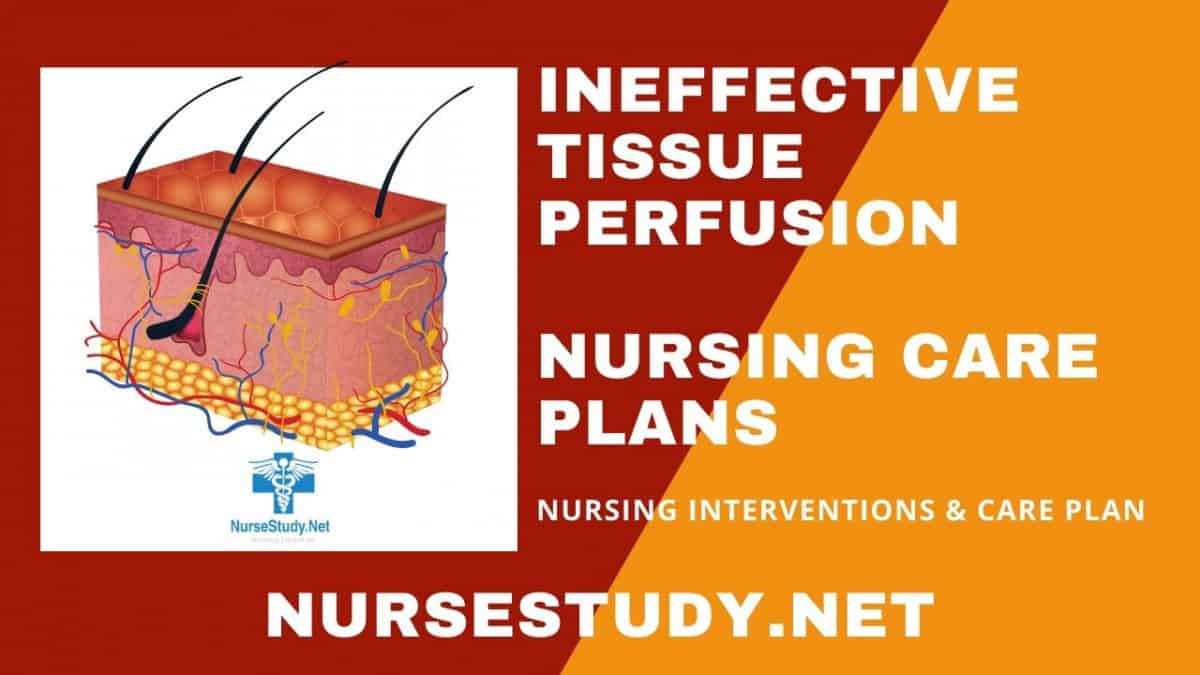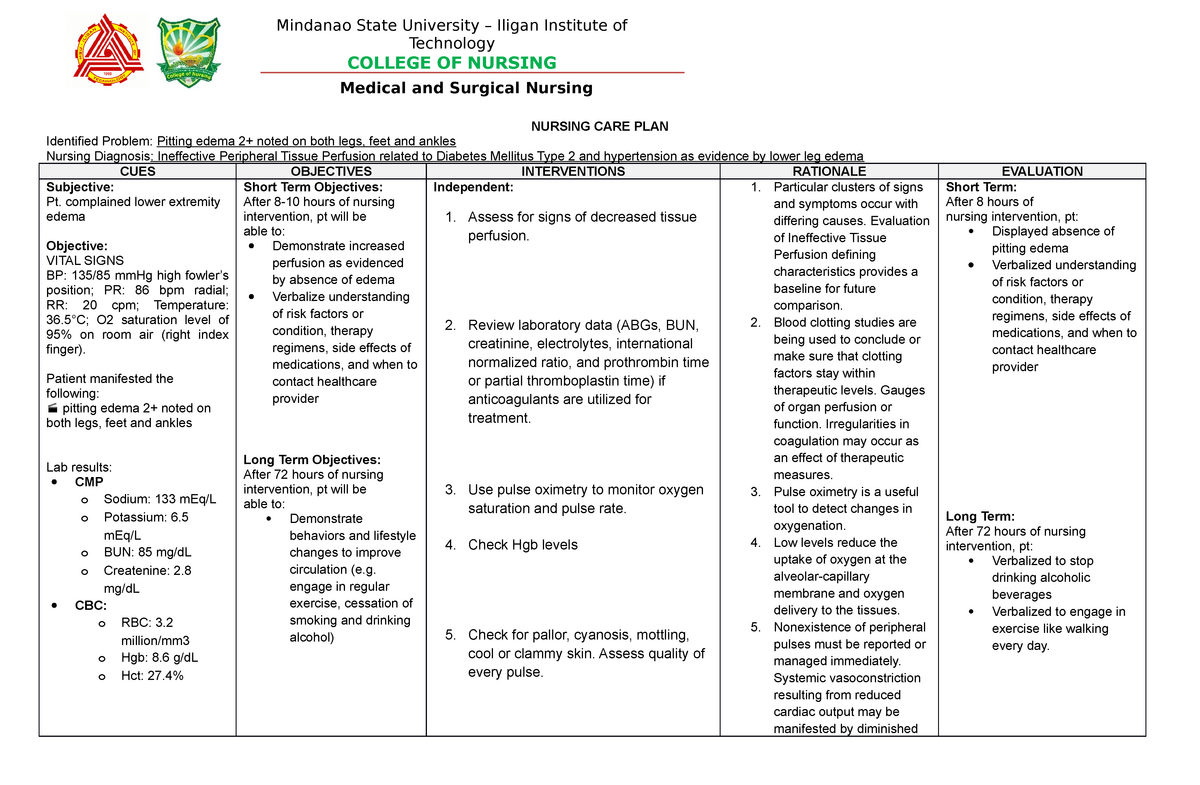Signs and Symptoms of Ineffective Tissue Perfusion
The skin may be cool to the touch and cyanosis may be present. When blood is blocked from the brain it does not receive necessary oxygen.

Ineffective Tissue Perfusion Nursing Diagnosis And Nursing Care Plan Nursestudy Net
Per-fuzhun 1.

. A liquid poured through or over an organ or tissue. The patient will develop an understanding of the importance of protecting the involved extremity from further injury. Evaluate the patients vital signs particularly blood pressure and pulse.
Explore the risk factors and symptoms associated with ineffective tissue. Constant monitoring is necessary to prevent ineffective tissue perfusion damage. Ineffective tissue perfusion is a state in which an individual has a decrease in oxygen resulting in failure to nourish the tissues at the capillary level.
A risk for diagnosis is not evidenced by signs and symptoms as the problem has not yet occurred and nursing interventions are directed at. What are the symptoms of ineffective tissue perfusion. Gauges of organ perfusion or function.
Understanding clinical signs of poor tissue perfusion during septic shock Intensive Care Med. Ineffective Cerebral Tissue Perfusion Care Plan. Tissue perfusion is a critical parameter for tissue survival and function and both relative and absolute perfusion assessments are highly relevant for both diagnosis and evaluation of the.
Monitoring of vital signs and neurological status. Ineffective tissue perfusion specify type renal cerebral. Tissue perfusion the circulation of blood through the vascular bed of tissue.
Be cautious for drops in blood pressure greater than 20 mm Hg compared to the patients baseline. Pain is part of the normal inflammatory process. Diminished tissue perfusion which is chronic in nature invariably results in tissue or organ damage or death.
There are four early warning signs of ineffective tissue perfusion. Soft tissue masses eg sarcoma B. Knowing the signs and symptoms of acute coronary syndrome allows healthcare staff to act fast.
The extent and depth of injury may affect pain sensations. Authors Hafid Ait-Oufella 1 2 Jan Bakker 3 4 5 Affiliations 1 Assistance Publique-Hôpitauxde Paris Hôpital. Decreased tissue perfusion can be transient with few or minimal consequences to the health of the patient.
The perfusion within the ineffective tissues can occur in various body systems like the peripheral cerebral renal. Urinary output may be difficult to assess due to collection or documentation errors so rising serum creatinine is another key indication of impaired renal. It is important to recognize the symptoms of an ineffective tissue perfusion nursing care plan.
Any signs of a STEMI or NSTEMI such as chest pain radiating to the arms shortness of breath or EKG changes indicate an obstruction in the coronary vessels preventing adequate perfusion of. Particular clusters of signs and symptoms occur with differing causes. Epub 2016 Feb 4.
Ineffective Tissue Perfusion Peripheral related to delayed peripheral wound healing secondary to peripheral arterial disease as evidenced by an open wound on the right big toe. Ineffective Tissue perfusion specify type. The initial sign of impaired renal perfusion is low urinary output.
Some symptoms of ineffective tissue perfusion are swelling mood changes. Ineffective tissue perfusion refers to a condition in which the body does not receive enough oxygenated blood. Renal gastrointestinal peripheral and cerebral.
A decreased oxygen level is also a sign of poor perfusion. Describe a diagnostic approachmethod to the patient with this problem. Ischemic chest pain which varies in severity may also develop.
Monitor site of impaired tissue integrity at least once daily for color changes redness swelling warmth. This deficiency can be identified through the diagnosis of the inadequate tissue perfusion symptoms and signs of organ failure mainly due to lack or inadequate circulation of oxygenated blood through body organs or system. Position patient to minimizes discomfort and facilitate respiration.
If the decreased perfusion is acute and protracted it can have devastating effects on the patient. Nursing Intervention for Ineffective Tissue Perfusion. If blood flow is not restored promptly this will result in tissue death.
Evaluation of Ineffective Tissue Perfusion defining characteristics provides a baseline for future comparison. Assess for signs of decreased tissue perfusion. Assess the patients level of pain.
Cerebral renal cardiopulmonary GI peripheral. The act of pouring through or over. Impaired renal perfusion may be caused by hypovolemia low cardiac output or physical blockage swelling thrombus etc.
Many times the diagnosis can be made through a careful history and physical and. Clinical signs of impaired tissue perfusion include the following. Any signs of a STEMI or NSTEMI such as chest pain radiating to the arms shortness of breath or EKG changes indicate an obstruction in the coronary vessels preventing adequate perfusion of myocardial tissue.
Irregular apical pulse adult pulse rate below 60 or above 100 beatsminute apical-radial pulse deficit syncope palpitations. Blood clotting studies are being used to conclude or make sure that clotting factors stay within therapeutic levels. This condition affects many body systems and organs and requires close monitoring.
Ineffective tissue perfusion describes the lack of oxygenated blood flow to areas of the body. Proper perfusion is detrimental to the function of organs and body systems as organs and tissues that are not perfusing will die. Assess for probable contributing factors related to temporarily impaired arterial blood flow.
Evaluation of Ineffective Tissue Perfusion defining characteristics provides a baseline for future comparison. Especially the passage of a fluid through the vessels of a specific organ. A decrease in blood pressure diminished peripheral pulses and slow capillary refill may also indicate poor perfusion.
Teach client to recognize the signs and symptoms that need to be reported to a physician eg change in skin temperature color sensation or presence of. Observe for related symptoms such as dizziness and impaired mental status. Women might have different symptoms such as gastrointestinal symptoms and jaw pain.
Assess for and report signssymptoms of cardiac dysrhythmias eg. Understanding the causes of inadequate perfusion assessment monitoring and interventions is imperative for nurses. Note the patients cardiac rhythm.
Ineffective tissue perfusion occurs when the exchange of gases nutrients and waste within the blood vessels is impaired. Particular clusters of signs and symptoms occur with differing causes.

Ncp 1 Risk For Ineffective Tissue Perfusion Tuguegarao City Cagayan 3500 Bachelor Of Science In Studocu

Ncp 5 Ineffective Tissue Perfusion Nursing Care Plan Identified Problem Pitting Edema 2 Noted On Studocu

Solution Nursing Care Plan Ineffective Tissue Perfusion Cardiopulmonary Ncp Studypool

Ineffective Tissue Perfusion Nursing Diagnosis Care Plan Nurseslabs
No comments for "Signs and Symptoms of Ineffective Tissue Perfusion"
Post a Comment